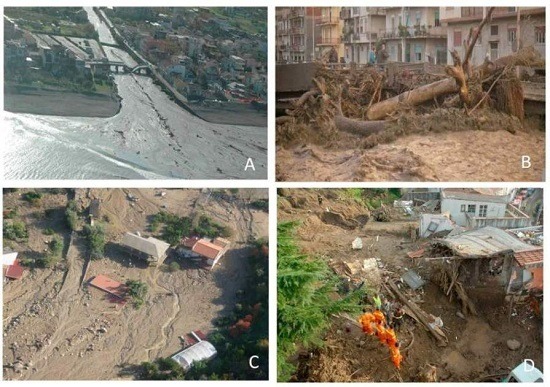Reconstruction of a Storm Map and New Approach in the Definition of Categories of the Extreme Rainfall, Northeastern Sicily
Abstract
:1. Introduction
2. Materials and Methods
2.1. Main Physical and Geomorphological Characteristics of the Area Hit by the Storm
2.2. Main Features of the 22 November 2011 Storm
2.3. Methods Used
3. Results and Discussion
3.1. Reconstruction of the Storm Map
3.2. Frequency Analyses
3.3. Transformation in the Standard Normal Distribution
4. Conclusions
Acknowledgments
Author Contributions
Conflicts of Interest
References
- Ljungqvist, F.C.; Krusic, P.J.; Sundqvist, H.S.; Zorita, E.; Brattström, G.; Frank, D. Northern Hemisphere hydroclimate variability over the past twelve centuries. Nature 2016, 532, 94–98. [Google Scholar] [CrossRef] [PubMed]
- Diodato, N.; Bellocchi, G. Storminess and Environmental Changes in the Mediterranean Central Area. Earth Interact. 2010, 14, 1–16. [Google Scholar] [CrossRef]
- Cevasco, A.; Diodato, N.; Revellino, P.; Fiorillo, F.; Grelle, G.; Guadagno, F.M. Storminess and geo-hydrological events affecting small coastal basins in a terraced Mediterranean environment. Sci. Total Environ. 2015, 532, 208–219. [Google Scholar] [CrossRef] [PubMed]
- Diodato, N. Spatial uncertainty modeling of climate processes for extreme hydrogeomorphological events hazard monitoring. J. Environ. Eng. ASCE 2006, 132, 1530–1538. [Google Scholar] [CrossRef]
- Clarke, M.; Rendell, H. Climate, extreme events and land degradation. In Climate and Land Degradation; Sivakumar, M.V.K., Ndiang’ui, N., Eds.; Springer: Berlin, Germany, 2007; pp. 137–152. [Google Scholar]
- Curtis, S.; Salahuddin, A.; Adler, R.F.; Huffman, G.J.; Gu, G.; Hong, Y. Precipitation extremes estimated by GPCP and TRMM: ENSO relationships. J. Hydrometeorol. 2007, 8, 678–689. [Google Scholar] [CrossRef]
- Zolina, O.; Simmer, C.; Belyaev, K.; Kapala, A.; Gulev, S. Improving estimates of heavy and extreme precipitation using daily records from European rain gauges. J. Hydrometeorol. 2009, 10, 701–716. [Google Scholar] [CrossRef]
- Wei, W.; Chen, L.; Fu, B. Effects of rainfall change on water erosion processes in terrestrial ecosystems: A review. Prog. Phys. Geogr. 2009, 33, 1–12. [Google Scholar] [CrossRef]
- Cannarozzo, M.; Noto, L.V.; Viola, F. Spatial distribution of rainfall trends in Sicily (1921–2000). Phys. Chem. Earth 2006, 31, 1201–1211. [Google Scholar] [CrossRef]
- Sanchez, J.; Gallardo, E.C.; Gaertner, M.; Arribas, A.; Castro, M. Future climate extreme events in the Mediterranean simulated by a regional climate model: A first approach. Glob. Planet. Chang. 2004, 44, 163–180. [Google Scholar] [CrossRef]
- Van Rompaey, A.; Bazzoffi, P.; Jones, R.J.A.; Montanarella, L. Modeling sediment yields in Italian catchments. Geomorphology 2005, 65, 157–169. [Google Scholar] [CrossRef]
- Diodato, N.; Bellocchi, G.; Romano, N.; Guadagno, F.M. Modelling the Rainfall Erosivity of the Rhone Region Associated with Climate Variability and Storminess. Adv. Meteorol. 2016, 21, 7626505. [Google Scholar]
- Papathoma, M.; Dominey-Howes, D. Tsunami vulnerability assessment and its implications for coastal hazard analysis and disaster management planning, Gulf of Corinth, Greece. Nat. Hazards Earth Syst. Sci. 2003, 3, 733–747. [Google Scholar] [CrossRef]
- Barroca, B.; Bernardara, P.; Mouchel, J.M.; Hubert, G. Indicators for identification of urban flooding vulnerability. Nat. Hazards Earth Syst. Sci. 2016, 6, 553–561. [Google Scholar] [CrossRef]
- Lionello, P.; Bhend, J.; Buzzi, A.; Della-Marta, P.M.; Krichak, S.O.; Jansà, A.; Maheras, P.; Sanna, A.; Trigo, I.F.; Trigo, R. (Eds.) Cyclones in the Mediterranean region: Climatology and effects on the environment. In Mediterranean Climate Variability; Elsevier: Amsterdam, The Netherlands, 2006; pp. 325–372.
- Mazzarella, A. Multifractal dynamic rainfall processes in Italy. Theor. Appl. Climatol. 1999, 63, 73–78. [Google Scholar] [CrossRef]
- Aronica, G.T.; Brigandí, G.; Morey, N. Flash floods and debris flow in the city area of Messina, north-east part of Sicily, Italy in October 2009: The case of the Giampilieri catchment. Nat. Hazards Earth Syst. Sci. 2012, 12, 1295–1309. [Google Scholar] [CrossRef]
- Schilirò, L.; Esposito, C.; Scarascia Mugnozza, G. Evaluation of shallow landslide-triggering scenarios through a physically based approach: An example of application in the southern Messina area (northeastern Sicily, Italy). Nat. Hazards Earth Syst. Sci. 2015, 15, 2091–2109. [Google Scholar] [CrossRef]
- Aronica, G.T.; Brigandì, G.; Marletta, C.; Manfre, B. Hydrological and hydraulic analysis of the flash flood event on 25 October 2007 in North-Eastern part of Sicily, Italy. In Proceedings of the Floodrisk 2008, Oxford, UK, 30 September–2 October 2008.
- Cama, M.; Lombardo, L.; Conoscenti, C.; Agnesi, V.; Rotigliano, E. Predicting storm-triggered debris flow events: Application to the 2009 Ionian Peloritan disaster (Sicily, Italy). Nat. Hazards Earth Syst. Sci. 2015, 15, 1785–1806. [Google Scholar] [CrossRef]
- Petrucci, O.; Polemio, M. The use of historical data for the characterisation of multiple damaging hydrogeological events. Nat. Hazards Earth Syst. Sci. 2003, 3, 17–30. [Google Scholar] [CrossRef]
- Drago, A.; Cartabellotta, D.; Lo Bianco, B.; Lombardo, M. Atlante Climatologico della Regione Siciliana; Assessorato Regionale Agricoltura e Foreste, UO di Agrometeorologia: Palermo, Iatly, 2000. [Google Scholar]
- Istituto Superiore per la Protezione e la Ricerca Ambientale (ISPRA). Geological Map of Italy, 1:50,000 Scale. Istituto Superiore per la Protezione e la Ricerca Ambientale (ISPRA): Rome, 2009. Available online: http://www.isprambiente.gov.it/Media/carg/ (accessed on 16 June 2016). [Google Scholar]
- Ingemi, D. Alluvione nel Messinese Tirrenico: Analisi di un Fenomeno Eccezionale Provocato Dall’effetto “Alcantara-Agrò”. 2011. Available online: http://www.meteoweb.eu/2011/11/alluvione-nel-messinese-tirrenico-analisi-di-un-fenomeno-eccezionale-provocato-dalleffetto-alcantara-agro/99210/ (accessed on 17 July 2016).
- Jenkinson, A.F. The frequency distribution of the annual maximum (or minimum) values of meteorological elements. Q. J. R. Meteorol. Soc. 1955, 81, 158–171. [Google Scholar] [CrossRef]
- Garbrecht, J.; Fernandez, G.P. Visualization of trends and fluctuations in climatic records. Water Resour. Bull. 1994, 30, 297–306. [Google Scholar] [CrossRef]
- Fiorillo, F.; Guadagno, F.M.; Aquino, S.; De Blasio, A. The December 1999 Cervinara landslides: Further debris flow in the pyroclastic deposits of Campania (Southern ltaly). Bull. Eng. Geol. Environ. 2001, 60, 171–184. [Google Scholar] [CrossRef]
- McCuen, R.H. Modelling Hydrologic Change; Lewis Publishers, CRC Press, Taylor & Francis Group: Boca Raton, FL, USA, 2003; p. 434. [Google Scholar]
- Battaglia, F.; Orfei, L. Outlier detection and estimation in nonlinear time-series. J. Time Ser. Anal. 2005, 26, 107–121. [Google Scholar] [CrossRef]
- McKee, T.B.; Doesken, N.J.; Kleist, J. The relationship of drought frequency and duration to time scales. In Proceedings of the 8th Conference on Applied Climatology, Anaheim, CA, USA, 17–22 January 1993; American Meteorological Society: Boston, MA, USA, 1993; pp. 179–184. [Google Scholar]
- Fiorillo, F.; Guadagno, F.M. Karst Spring Discharges Analysis in Relation to Drought Periods, Using the SPI. Water Resour. Manag. 2010, 24, 1867–1884. [Google Scholar] [CrossRef]
- Bonaccorso, B.; Cancelliere, A.; Rossi, G. Detecting trends of extreme rainfall series in Sicily. Adv. Geosci. 2005, 2, 7–11. [Google Scholar] [CrossRef]
- Notaro, V.; Liuzzo, L.; Freni, G.; La Loggia, G. Uncertainty Analysis in the Evaluation of Extreme Rainfall Trends and Its Implications on Urban Drainage System Design. Water 2015, 7, 6931–6945. [Google Scholar] [CrossRef]
- D’Asaro, F.; D’Agostino, L.; Bagarello, V. Assessing changes in rainfall erosivity in Sicily during the twentieth century. Hydrol. Process. 2007, 21, 2862–2871. [Google Scholar] [CrossRef]
- Polemio, M.; Petrucci, O. The occurrence of floods and the role of climate variations from 1880 in Calabria (Southern Italy). Nat. Hazards Earth Syst. Sci. 2012, 12, 129–142. [Google Scholar] [CrossRef]
- Fiorillo, F.; Wilson, R.C. Rainfall induced debris flows in pyroclastic deposits, Campania (southern Italy). Eng. Geol. 2004, 75, 263–289. [Google Scholar] [CrossRef]

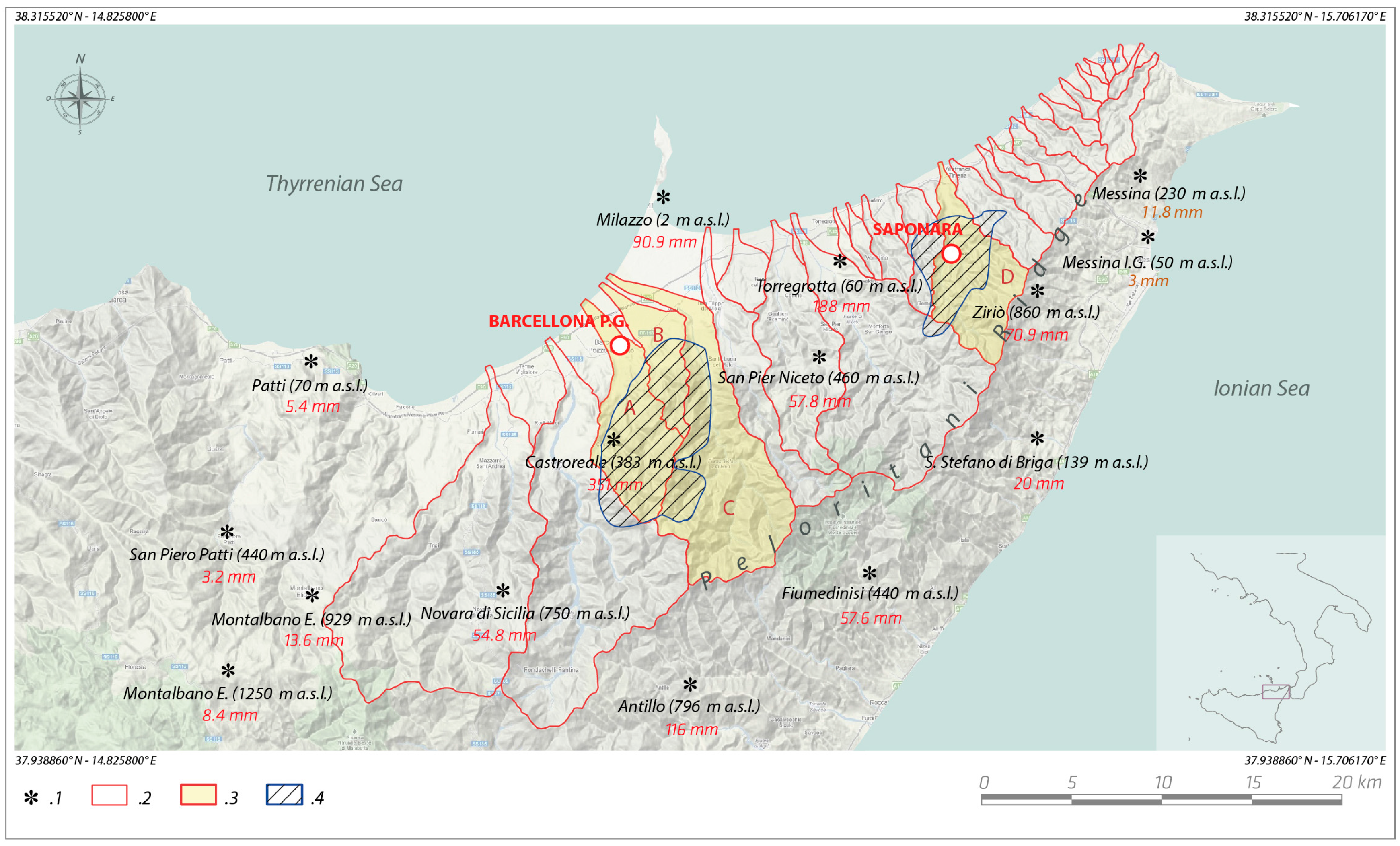

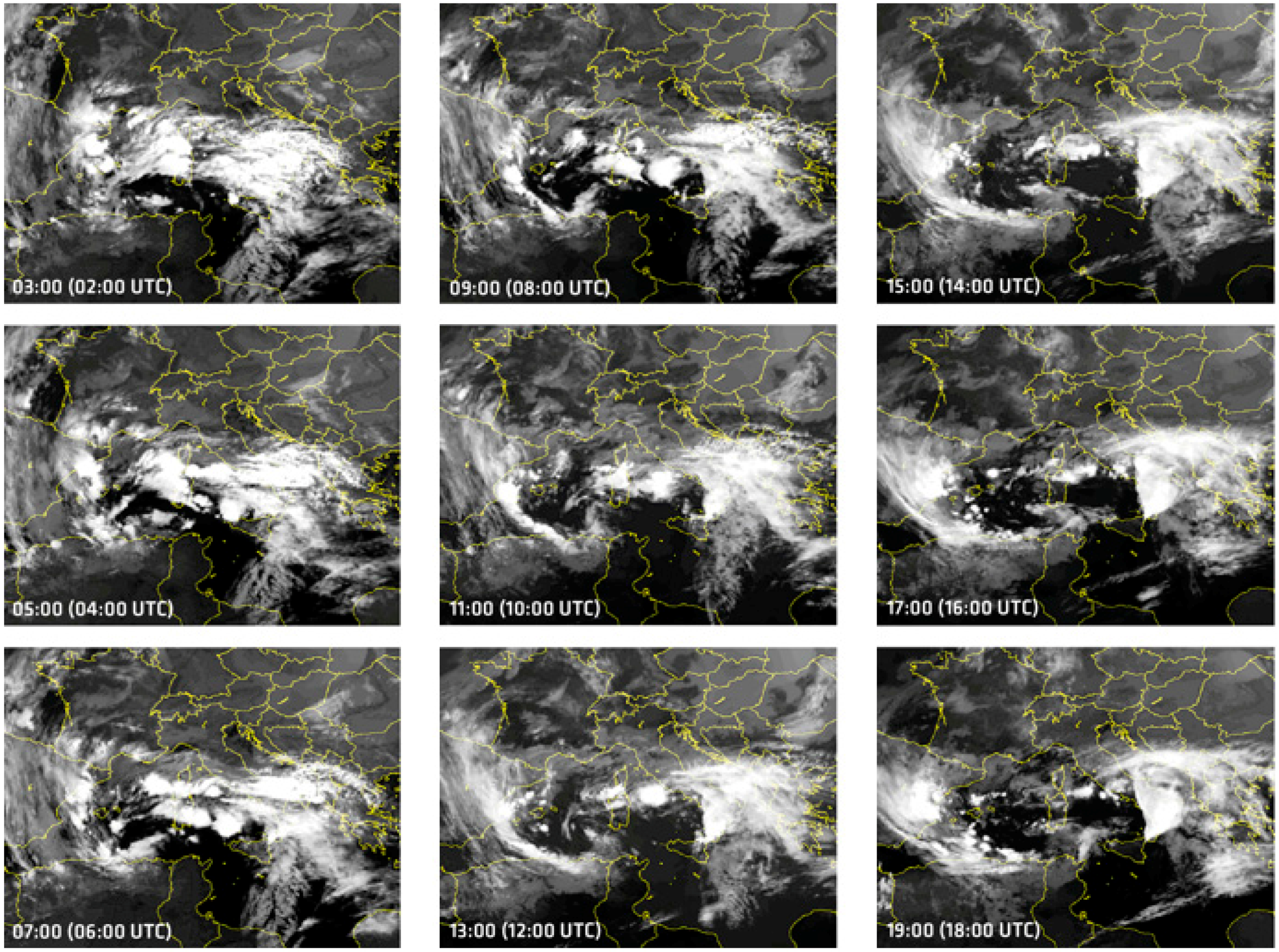


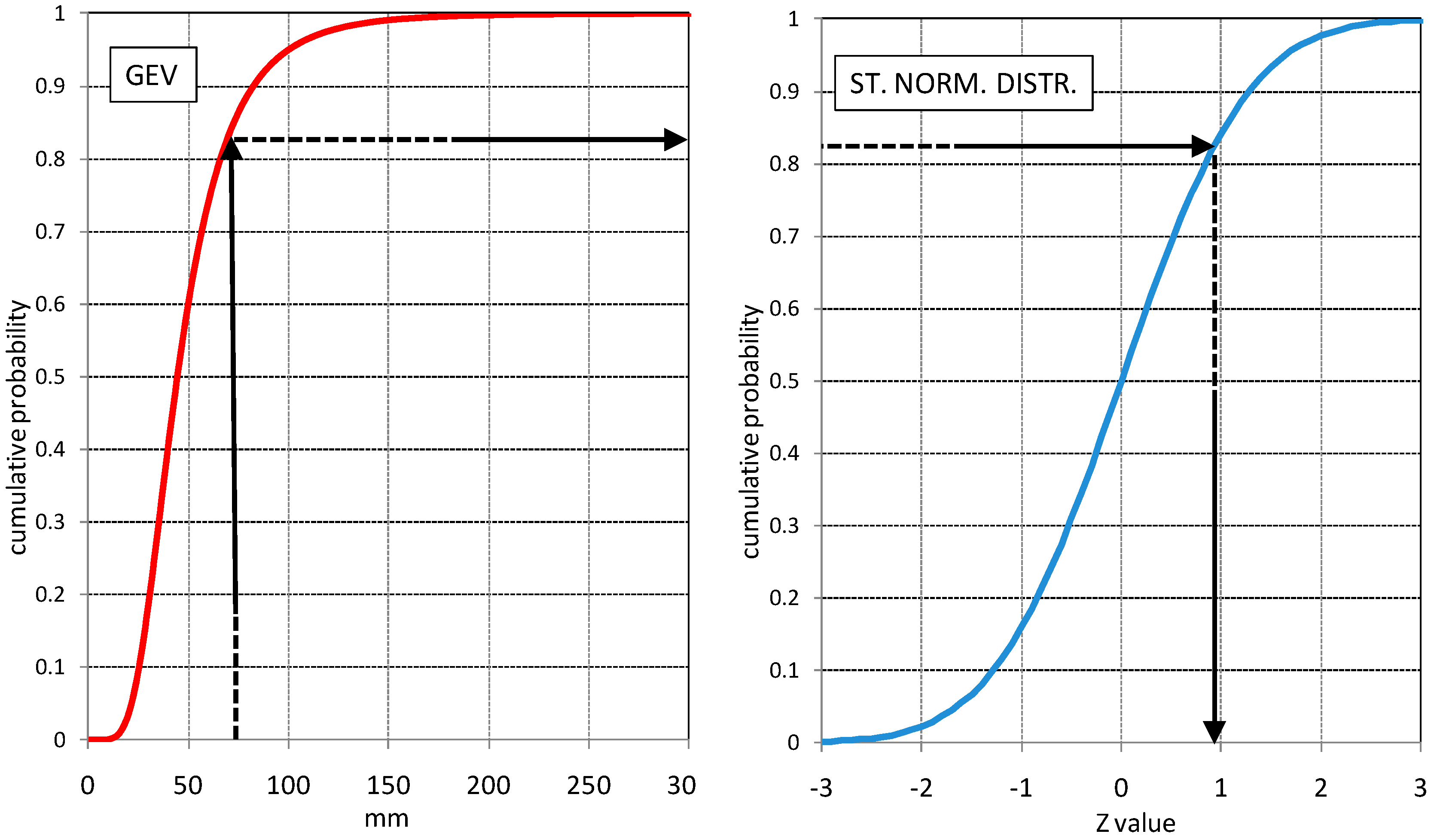

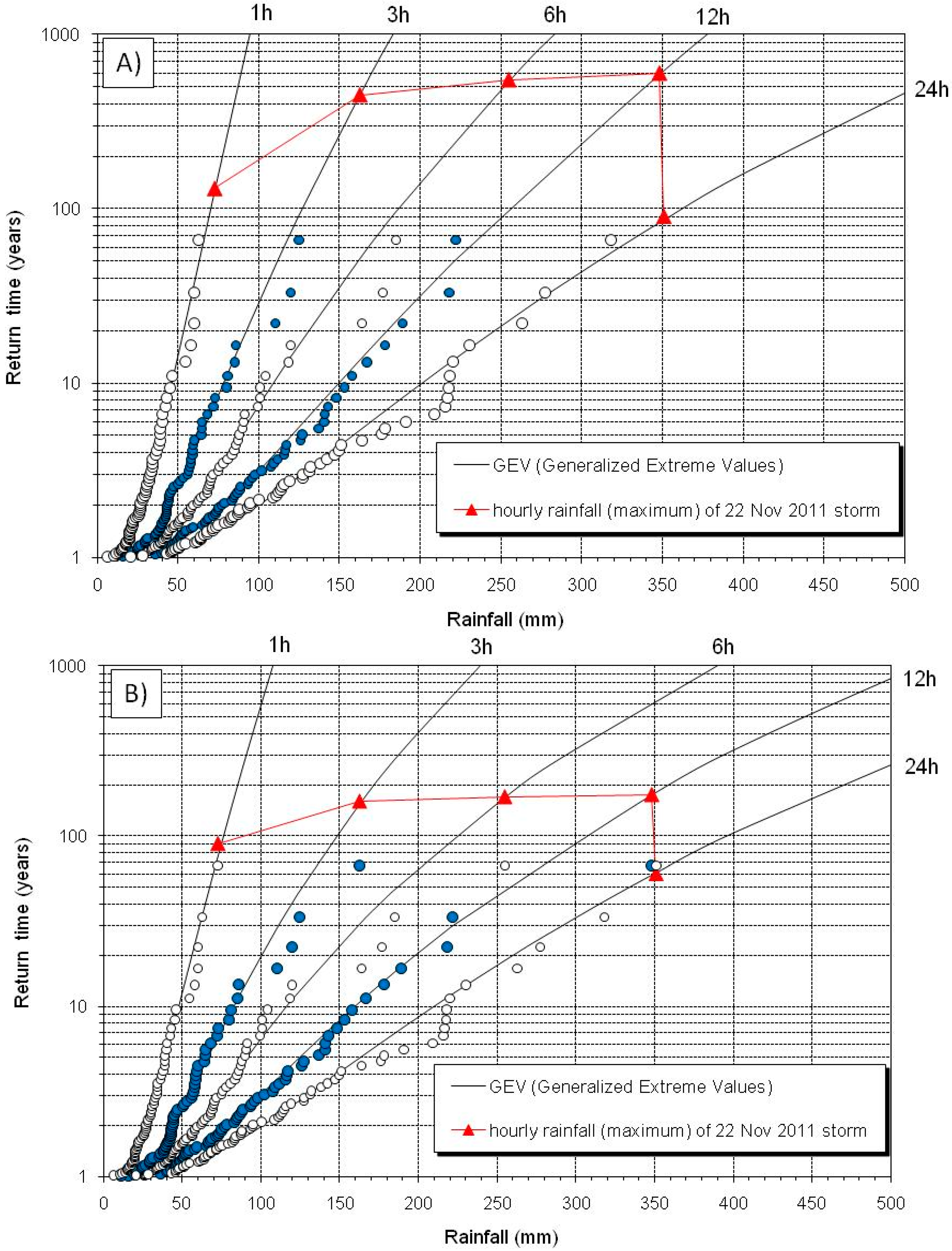

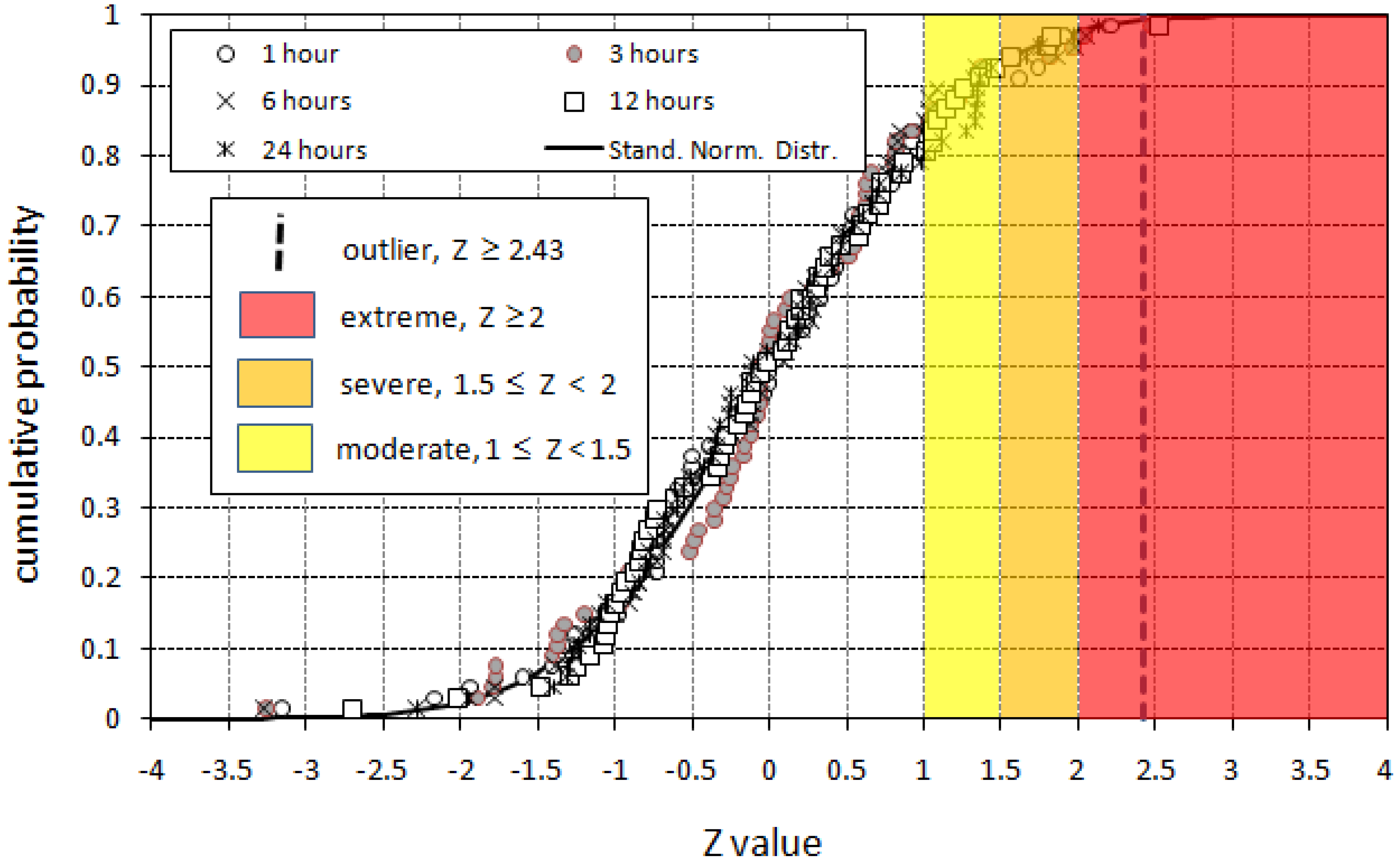
| Network | Rain Gauge | Elevation (m a.s.l.) | Accumulated Rainfall between 0:00 and 24:00; (mm) |
|---|---|---|---|
| OSSERVATORIO DELLE ACQUE | Milazzo | 2 | 90.9 |
| Ziriò—(Saponara) | 860 | 70.9 | |
| Castroreale | 383 | 351 | |
| Montalbano E. | 929 | 13.6 | |
| S.Stefano Briga | 139 | 20 | |
| Messina (Ist.Geof.) | 50 | 3 | |
| S.Piero Patti | 440 | 3.2 | |
| SIAS | Torregrotta | 60 | 188.8 |
| Montalbano E. | 1250 | 8.4 | |
| San Pier Niceto | 460 | 57.8 | |
| Antillo | 796 | 116.2 | |
| Novara di Sicilia | 750 | 54.8 | |
| Patti | 70 | 5.4 | |
| Fiumedinisi | 440 | 57.6 | |
| Messina | 230 | 11.8 |
| Time Series | 1 h | 3 h | 6 h | 12 h | 24 h |
|---|---|---|---|---|---|
| period 1930–2010, 65 years (mm) | 62.8 | 124.8 | 185 | 222 | 318 |
| 22 November 2011 storm (mm) | 72.5 | 162.5 | 254.8 | 348.2 | 351 |
| Categories of Maxima | Storm Year | 1 h | 3 h | 6 h | 12 h | 24 h | |
|---|---|---|---|---|---|---|---|
| Extreme | Z ≥ 2 | 1978 | – | 2.04 | – | – | – |
| 2008 | – | – | 2.05 | – | – | ||
| 2011 | 2.21 | 2.47 | 2.52 | 2.53 | 2.13 | ||
| Severe | 1.5 ≤ Z < 2 | 1943 | – | – | – | 1.56 | 1.66 |
| 1949 | – | – | – | 1.83 | 1.97 | ||
| 1978 | 1.91 | – | 1.98 | – | – | ||
| 1995 | 1.74 | – | – | – | – | ||
| 2004 | 1.82 | – | – | – | – | ||
| 2008 | – | 1.97 | – | 1.80 | – | ||
| 2010 | 1.61 | 1.82 | 1.86 | – | 1.75 | ||
© 2016 by the authors; licensee MDPI, Basel, Switzerland. This article is an open access article distributed under the terms and conditions of the Creative Commons Attribution (CC-BY) license (http://creativecommons.org/licenses/by/4.0/).
Share and Cite
Fiorillo, F.; Diodato, N.; Meo, M. Reconstruction of a Storm Map and New Approach in the Definition of Categories of the Extreme Rainfall, Northeastern Sicily. Water 2016, 8, 330. https://doi.org/10.3390/w8080330
Fiorillo F, Diodato N, Meo M. Reconstruction of a Storm Map and New Approach in the Definition of Categories of the Extreme Rainfall, Northeastern Sicily. Water. 2016; 8(8):330. https://doi.org/10.3390/w8080330
Chicago/Turabian StyleFiorillo, Francesco, Nazzareno Diodato, and Massimiliano Meo. 2016. "Reconstruction of a Storm Map and New Approach in the Definition of Categories of the Extreme Rainfall, Northeastern Sicily" Water 8, no. 8: 330. https://doi.org/10.3390/w8080330
APA StyleFiorillo, F., Diodato, N., & Meo, M. (2016). Reconstruction of a Storm Map and New Approach in the Definition of Categories of the Extreme Rainfall, Northeastern Sicily. Water, 8(8), 330. https://doi.org/10.3390/w8080330






